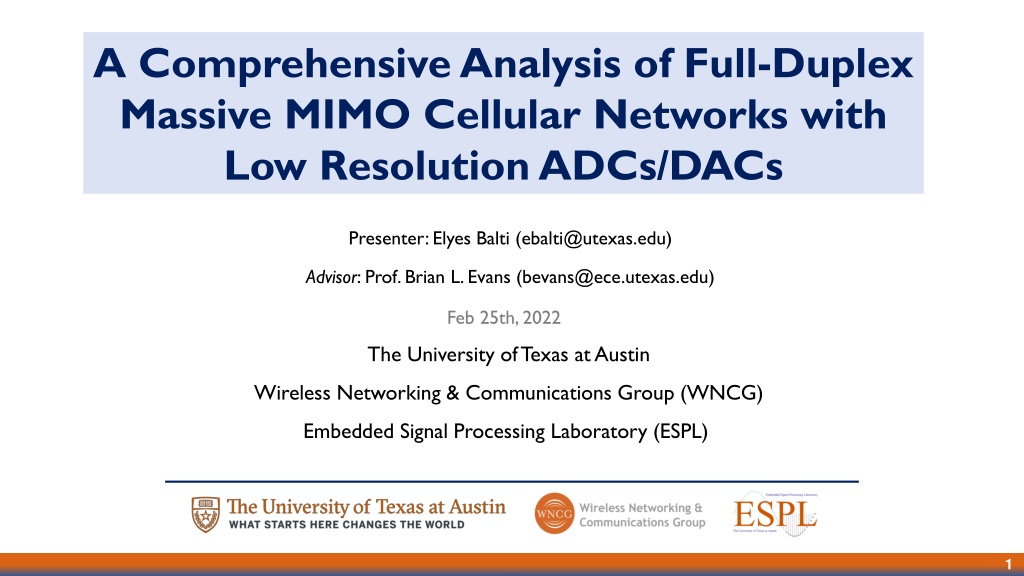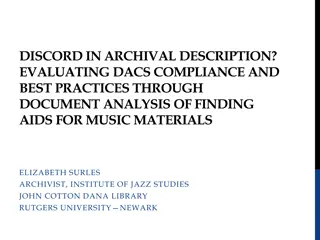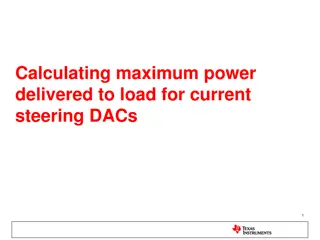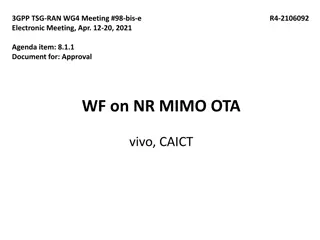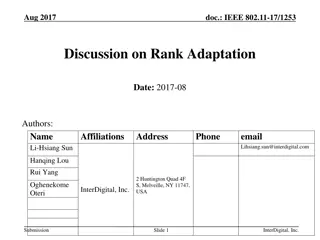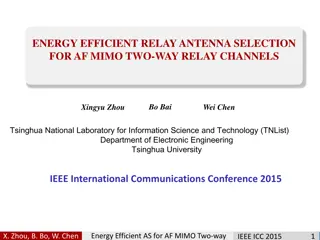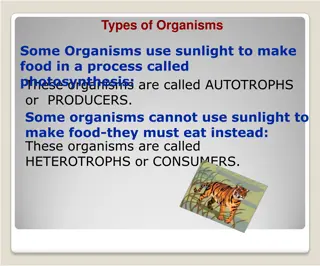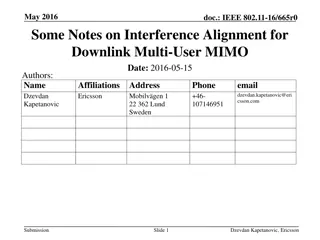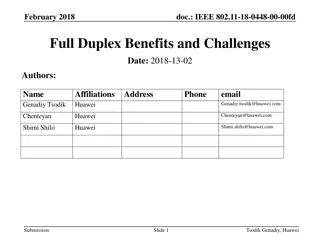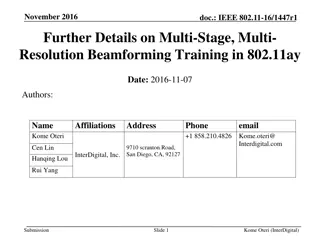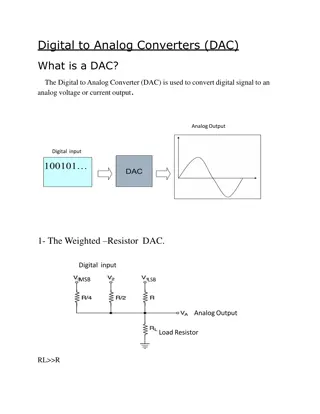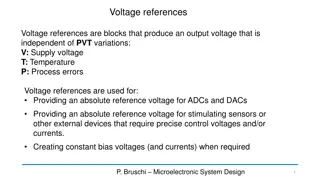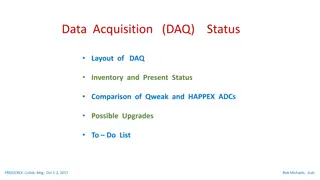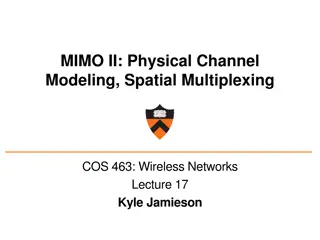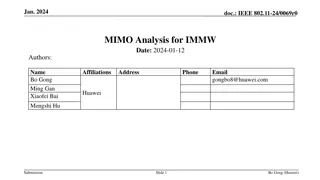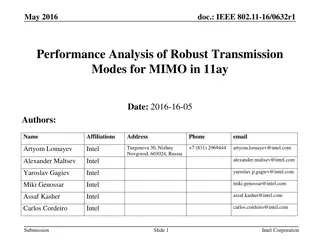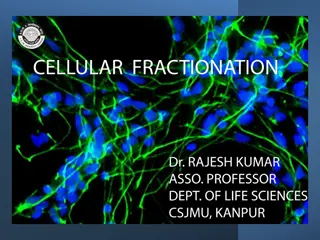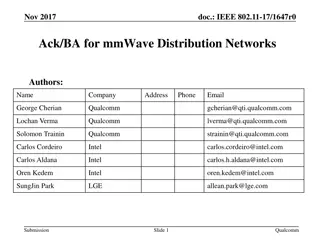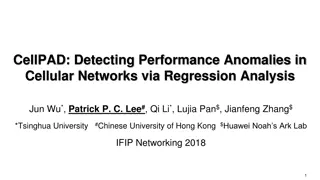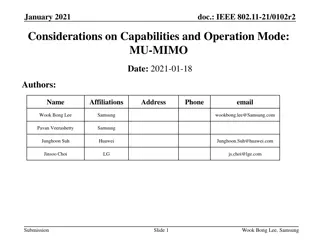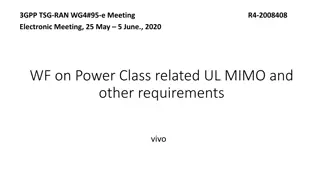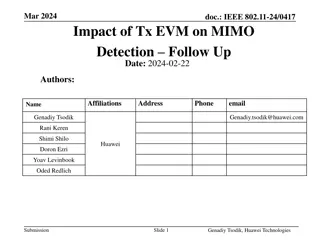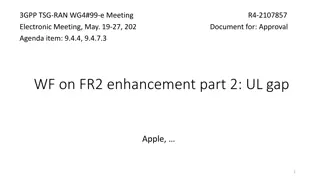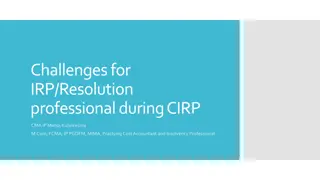Comprehensive Analysis of Full-Duplex Massive MIMO Cellular Networks with Low-Resolution ADCs/DACs
Explore the feasibility and advantages of full-duplex massive MIMO technology in cellular networks, focusing on enhancing spectral efficiency, reducing latency, and improving reliability. Discuss challenges such as self-interference and propose solutions like using low-resolution ADCs/DACs. The study aims to outperform half-duplex systems in terms of efficiency and performance.
- Full-Duplex Massive MIMO
- Cellular Networks
- Spectral Efficiency
- Low-Resolution ADCs
- Wireless Communications
Download Presentation

Please find below an Image/Link to download the presentation.
The content on the website is provided AS IS for your information and personal use only. It may not be sold, licensed, or shared on other websites without obtaining consent from the author. Download presentation by click this link. If you encounter any issues during the download, it is possible that the publisher has removed the file from their server.
E N D
Presentation Transcript
A Comprehensive Analysis of Full-Duplex Massive MIMO Cellular Networks with Low Resolution ADCs/DACs Presenter: Elyes Balti (ebalti@utexas.edu) Advisor: Prof. Brian L. Evans (bevans@ece.utexas.edu) Feb 25th, 2022 The University of Texas at Austin Wireless Networking & Communications Group (WNCG) Embedded Signal Processing Laboratory (ESPL) 1
Motivation Benefits: double the spectral efficiency, reduce the latency, enhance the reliability/coverage due to the transmission and reception at the same resource block (time/frequency), and reduction of the number of antennas by a factor of 2 (e.g., shared TX and RX arrays of full-duplex transceivers). Applications: machine-to-machine, cellular systems, integrated access and backhaul. Currently proposed in 3GPP Release 17. Machine-to-Machine Integrated Access and Backhaul https://www.qualcomm.com/news/onq/2019/12/13/3gpp-charts-next-chapter-5g-standards E. Balti and N. Mensi, "Zero-Forcing Max-Power Beamforming for Hybrid mmWave Full- Duplex MIMO Systems," 2020 4th International Conference on Advanced Systems and Emergent Technologies (IC_ASET), 2020, pp. 344-349 E. Balti and B. L. Evans, "Hybrid Beamforming Design for Wideband MmWave Full- Duplex Systems," arxiv, 2021 Cellular 2
Objectives/Challenges/Solutions Objectives Prove the feasibility of the FD massive MIMO in the context of cellular networks. Outperform the half-duplex mode in terms of CDF and spectral efficiency. Evaluate the signal-to-quantization-plus-interference-plus-noise ratio (SQINR) for reverse and forward links. Derive a unified analytical cellular model accounting for all the network irregularities and imperfections. Challenges 1. Vulnerable to the loop-back self-interference (SI). 2. SI signal power can be up to 90-100 dB higher than the received signal power. 3. In cellular systems, the SI is large with the cell-edge users. 4. ADCs saturation by the SI resulting in poor spectral efficiency. 5. Large number of antennas leads to hefty power consumption. Solutions 1. Massive number of antennas provides enough degree of freedom to suppress the SI. 2. Employ low-resolution ADCs/DACs at the full-duplex base station to reduce the power consumption. 3. Combination of FD, massive MIMO, and low-resolution ADCs/DACs may solve the problems of loopback SI and the hefty power consumption in order to improve the spectral and energy efficiencies. 3
Network Geometries (a) Hexagonal Lattice (b) Square Grid (c) Voronoi Tessellation Fig.1. (a). The cell of interest and the gray cells are the ones reusing the same pilot dimensions and a copilot user in each cell is indicated by a circle. (b) and (c) consist of a realization of homogeneous cellular networks. The square grid consists of regular deployment of BSs while the users devices are uniformly distributed in the cells. Poisson Point Process (PPP) network model wherein the BSs deployment and users are distributed according to PPP in (c). 4
System Model 1. BSs are operating in full-duplex (FD) mode and with low-resolution ADCs/DACs. 2. BSs are equipped with massive number of antennas while the users are equipped with single antenna and operate in half-duplex and full- resolution ADC/DAC. 3. Matched filters receivers and precoders are applied at the receive and transmit arrays of the BSs. 4. Bussgang Linearization model to linearize the quantization distortion (??= ?? + ?), ?: AQNM uncorrelated with ? and ?: scale for resolution. 5. Introduce the pilot contamination into the model since the pilot dimensions are finite. 6. The uplink users are corrupted by the SI (caused by the downlink transmission) while the downlink users are vulnerable to the inter-user interference caused by the uplink users. (a) Fig.2 (a): Basic abstractions of a FD BS. The uplink and downlinks users independently exchange the data with the BS. A loopback SI is created and corrupts the uplink users. (b): Basic abstraction of an all-digital combiner. (b) 5
Simulation Parameters Hexagonal lattice is simulated with 2-tier (19 cells). Square grid is simulated with 25 cells. BS and UE densities are specified for the PPP simulation. Uniform power allocation for the forward links. Power control for the reverse links. Channels are estimated in the reverse phase. Channels reciprocity is applied in the forward phase assuming TDD. 6
Numerical Results (a). Forward Link. (b). Forward Link. (c). Reverse Link. PPP is more accurate as it accounts for more irregularities than the regular hexagonal and square grids. Massive number of antennas can sharp the beams and hence reject the cellular interference as well as the SI, however, the SQINR is limited by the pilot contamination. The effects of pilot overhead and pilot contamination are not significant. The proposed system outperforms the half-duplex BSs cellular network which is one of the goal of this work. 7
Appendix 1. Application of adaptive LMS for self-interference cancellation: E. Balti and B. L. Evans, Adaptive Self-Interference Cancellation for Full-Duplex Wireless Communication Systems," arxiv, 2021 Reproducible research: : https://github.com/ebalti/Full-DuplexSteepest-Descent 2. Application of Gradient Ascent to design the beamformers for full-duplex systems: E. Balti, Adaptive Gradient Search Beamforming for Full-Duplex mmWave MIMO Systems," arxiv, 2020 3. Application of alternating projection method to two-node full-duplex systems: E. Balti and N. Mensi, "Zero-Forcing Max-Power Beamforming for Hybrid mmWave Full-Duplex MIMO Systems," 2020 4th International Conference on Advanced Systems and Emergent Technologies (IC_ASET), 2020, pp. 344-349 4. Application of full-duplex in single-cell single-user MIMO case: E. Balti and B. L. Evans, Joint Beamforming and Interference Cancellation in mmWave Wideband Full-duplex MIMO Systems , submitted to IEEE Transactions on Wireless Communications E. Balti and B. L. Evans, Hybrid Beamforming Design for Wideband mmWave Full-Duplex Systems , submitted to IEEE Transactions on Communications 5. Application of full-duplex with low resolution ADC/DAC on cellular networks: E. Balti and B. L. Evans, Full-Duplex Massive MIMO Cellular Networks with Low Resolution ADC/DAC , E. Balti and B. L. Evans, A Comprehensive Analysis of Full-Duplex Massive MIMO Cellular Networks with Low Resolution ADC/DAC , Journal under preparation E. Balti and B. L. Evans, Reverse Link Analysis for Full-Duplex Cellular Networks with Low Resolution ADC/DAC . E. Balti and B. L. Evans, Forward Link Analysis for Full-Duplex Cellular Networks with Low Resolution ADC/DAC . 6. Integrated Access and Backhaul E. Balti and B. L. Evans, Full-Duplex Wideband mmWave Integrated Access and Backhaul with Low Resolution ADCs . 8
